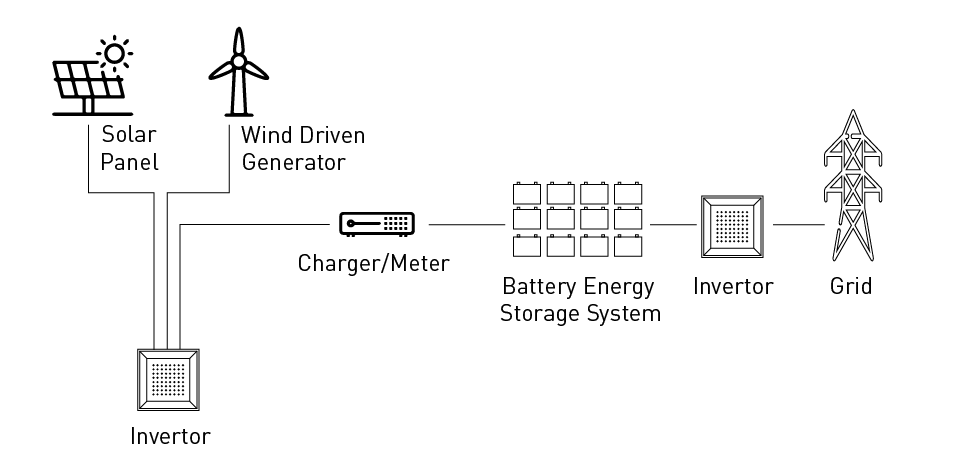Types of Grid Storage
Energy storage systems are crucial for improving the flexibility, efficiency, and reliability of the electrical grid. They are crucial to integrating renewable energy sources, meeting peak demand, increasing power quality, and ensuring power stability. Among the many grid storage technologies, Battery Energy Storage Systems (BESS), Energy Capacitor Systems (ECS), and Flywheel Energy Storage Systems (FESS) stand out because of to their unique features and uses. This section delves into each of these kinds of grid storage, offering insight into their mechanics, advantages, and roles in the power grid.
Battery Energy Storage Systems (BESS)
Battery energy storage systems use electrochemical processes to store and release energy. These systems are extremely adaptable, ranging from tiny home applications to huge utility-scale installations. BESS can retain extra energy created during low demand periods, notably from intermittent renewable sources such as solar and wind, and then release it during peak demand periods. This capacity makes BESS ideal for load balancing, peak shaving, and emergency backup power. Advances in battery technology, notably lithium-ion, have considerably increased BESS efficiency, lifetime, and cost-effectiveness, establishing them as a foundation for modern energy storage systems.

Figure 23: BESS concept
Energy Capacitor Systems (ECS)
Energy Capacitor Systems, also known as supercapacitors or ultracapacitors, store energy in an electric field between two electrodes, allowing for fast charging and discharging. While ECS usually have a lower energy density than batteries, they excel at delivering high power over short periods. This makes them excellent for applications that need short bursts of energy, such as grid voltage support and frequency control. Their large power capacity, extended cycle life, and ability to operate across a wide temperature range supplement other storage technologies, particularly in terms of improving power quality and grid stability.
Flywheel Energy Storage Systems (FESS)
Flywheel Energy Storage Systems store kinetic energy in a rotating mass. When there is surplus grid power, it powers a motor that spins the flywheel, storing energy as rotational kinetic energy. During moments of heavy demand or when the grid requires stability, the stored kinetic energy is transformed back into electrical energy using a generator. FESS are renowned for their high-power output, rapid response times, and extended service life, with little degradation over time. They are especially beneficial for short-term energy storage applications including regulating the frequency and bridging electricity during momentary outages.
Functions
Energy storage systems (ESS) have become essential components of modern power grids, providing solutions to a wide range of issues associated with the increased integration of renewable energy sources and the complexity of electrical networks. These systems play critical roles in meeting peak demand, improving power quality, and increasing power stability. This section discusses the operations of energy storage systems and their importance in maintaining a reliable, effective, and sustainable power supply.
Meeting Peak Demand
One of the key roles of energy storage systems is to satisfy peak demand during times when consumption of electricity is highest. During these times, energy storage devices can swiftly release stored electricity to the grid, relieving strain on power plants and avoiding the need to activate additional, typically inefficient and polluting, peaking power plants. Energy storage serves to keep supply and demand in balance by leveling the load, ensuring that energy is accessible when and where it is most required. This capacity not only improves grid resilience, but it also helps to reduce energy costs and carbon emissions by making the most use of renewable and base-load electricity sources during off-peak hours.
Improving Power Quality
Power quality is crucial for electrical equipment efficiency and reducing power system losses. Energy storage systems help to improve power quality by reducing voltage fluctuations, flicker, and harmonics, which can be caused by intermittent renewable generating or varying loads. Energy storage systems can resolve these disruptions instantly by charging and discharging quickly and precisely, delivering a steady and constant power supply. This is especially critical in networks with a large proportion of renewable energy sources since electrical power unpredictability can have a major influence on power quality.
Enhancing Power Stability
Power stability, which includes both frequency and voltage stability, is critical to the smooth running of the power grid. Energy storage systems improve electricity stability by offering ancillary services like frequency control and voltage support. They can adapt fast to changes in grid conditions, such as unexpected increases or decreases in power supply or demand, assisting in keeping the frequency and voltage within acceptable operational limits. For example, in the case of a generator failure, energy storage devices can rapidly restore power to the grid, eliminating frequency dips that might cause widespread grid instability or even blackouts. Similarly, by providing reactive power, energy storage can help sustain voltage levels, hence promoting grid stability under changing load conditions.
Challenges and Future Directions
While the advantages of energy storage are obvious, challenges remain in terms of cost, technical development, and interaction with present grid infrastructure. Advances in materials science, system design, and energy management software are predicted to drive down storage system prices while improving their capabilities. Furthermore, regulatory and market changes are required to fully realize the promise of energy storage, allowing it to play a revolutionary role in the transition to a more sustainable, reliable, and flexible power grid.


直接登录
创建新帐号